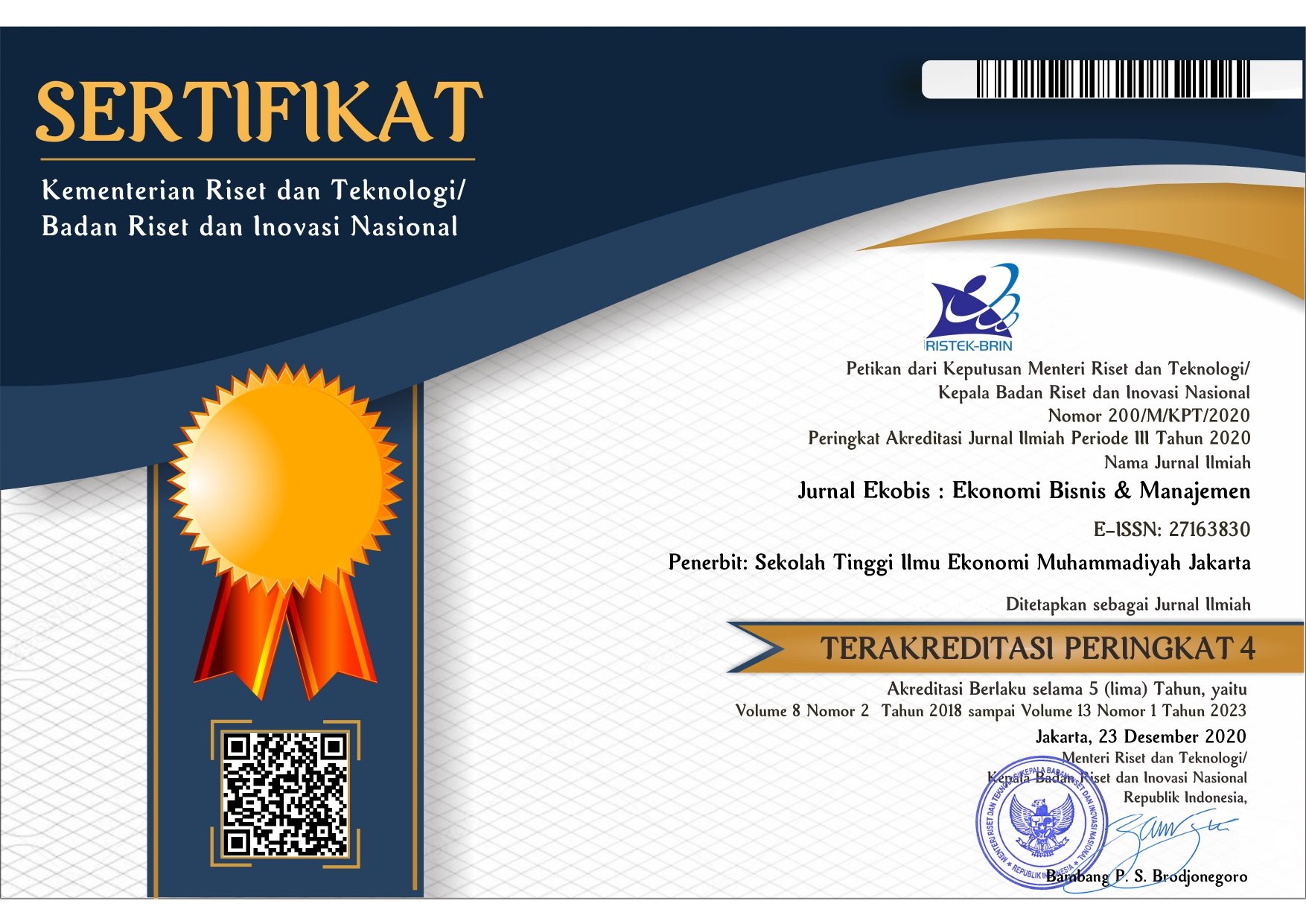ANALISIS VOLATILITAS IMBAL HASIL REKSADANA SAHAM (STUDI KASUS PADA REKSADANA SCHRODER DANA PRESTASI PLUS)
DOI:
https://doi.org/10.37932/j.e.v8i2.38Keywords:
Mutual fund yields, volatility, asymmetric behavior, persistenceAbstract
This research aims to analyze the empirical evidence of the volatility of stock mutual fund returns. The data used is the daily yield data of Schroder Dana Prestasi Plus mutual funds. The analytical methods used in this study are GARCH (Generalized Auto Regression Heteroscedasticity) and EGARCH (Exponential Generalized Auto Regitional Heteroscedasticity). The results showed that the yield of Schroder Dana Prestasi Plus stock mutual funds proved significantly that there was a time varying volatility phenomenon. Then the volatility in the yield of Schroder Dana Prestasi Plus stock mutual funds was proven to be significantly unaffected by the asymmetric behavior therein. And the level of persistence in the volatility is quite low.References
Adler H.M.dan Widhi I.N. (2005). “Pengaruh Variabel Makro terhadap Hubungan Conditional Mean and Conditional Volatility IHSG”. Usahawan, No.06 Tahun XXXIV.
Anton. (2006). “Analisis Model Volatilitas Return Saham”. Tesis. Universitas Diponegoro. Semarang.
Abdalla, SZS. & Winker, P. (2012). “Modelling Stock Market Volatility Using Univariate GARCH Models: Evidence from Sudan and Egypt”. International Journal of Economics and Finance; Vol. 4, No. 8.
Bollerslev, T. et.all. (1986). “Glosary to ARCH (GARCH)”, Volatility and Time Series, Vol.8, pp:137-164.
Dennis, Steven A. and Ah Bon Sim. (1999). “Share Price Volatility with the Introduction of Individual Share Futures on the Sydney Futures Exchange”. International Review of Financial Analysis 6(2), p:153-163
Engle, Robert F. (1982). “Autoregressive Conditional Heteroscedasticity With Estimate of the Variance of UK Inflation”. Journal Econometrica, Vol.50, pp:987-108.
Eliyawati, Hidayat, & Azizah. (2011). “Penerapan Model GARCH (Generalized Autoregressive Conditional Heteroscedasticity) Untuk Menguji Pasar Modal Efisien di Indonesia”. Jurnal Administrasi Bisnis, Vol.7.
Eduardus Tandelilin. (2002). Analisis Investasi dan Manajemen Portofolio, Edisi 3. BPFI. Yogyakarta.
French KR, Schwert GW, Stambaugh RE. (1987). “Expected Stock Returns and Volatility”. Journal of Financial Economics, No.19, pp:3-29.
Jones, Charles P. (2004), Investment. Prentice- Hall . New York.
Kartika, Andi. (2010). “Volatilitas Harga Saham di Indonesia dan Malaysia”. Jurnal Aset, Vol.12, No.1, pp:17-26.
Markowitz, H. (1952). “Portofolio Selection”. Journal of Finance, Vol.7, pp:77-91.
Markowitz, H. (1959). Portfolio Selection. : Efficient Diversification of Invesment, John Willey & Sons, New York.
Seyfried, William L and Ewing, Bradley T. (2004). “A Time Varying Volatility Approach To Modeling The Philips Curve : A Cross- Country Analysis”. Journal of Economics and Finance, Vol.28, No.2, pp:186-197
Sabbaghi, Omid. (2011). “Asymmetric volatility and trading volume: The G5 evidence”. Global Finance Journal, Vol.22, pp:169- 181.
Schwert, G. William. (1989). “Why Does Stock Market Volatility Change Over Time?”, Journal of Finance, Vol.44, No.5, pp:1115- 1153.
Schwert, G.W. dan Clifford W. Smith, Jr. (1992). Empirical Research in Capital Market, McGrawHill, Inc, USA.
Travers. (1978), Elementary Survey Sampling. Wadsworth Pub, Co. New York.
Wibowo, Buddi. (2004). “Pengujian Tuntas atas Anomali Pola Harian dan Efek Akhir Pekan pada Return dan Volatility IHSG dan LQ45 (1994-2004)”. Usahawan , No.12, Tahun XXXIII, pp:3-7.
Downloads
Published
How to Cite
Issue
Section
License
Copyright Notice
Copyright
Authors retain copyright and grant the journal right of first publication with the work simultaneously licensed under a Creative Commons Attribution-ShareAlike 4.0 International License that allows others to share the work with an acknowledgment of initial publication in this journal.
Authors are permitted and encouraged to post their work online (e.g., in institutional repositories or on their website) before and during the submission process, as it can lead to productive exchanges and earlier and greater citation of published work (See The Effect of Open Access).
License
You are free to:
- Share — copy and redistribute the material in any medium or format
- Adapt — remix, transform, and build upon the material
- for any purpose, even commercially.
Under the following terms:
-
Attribution — You must give appropriate credit, provide a link to the license, and indicate if changes were made. You may do so in any reasonable manner, but not in any way that suggests the licensor endorses you or your use.
-
ShareAlike — If you remix, transform, or build upon the material, you must distribute your contributions under the same license as the original.
- No additional restrictions — You may not apply legal terms or technological measures that legally restrict others from doing anything the license permits.
Jurnal Ekobis: Ekonomi Bisnis & Majemen is licenced under Creative Commons Attribution-ShareAlike 4.0 International (CC BY-SA 4.0).
Privacy Statement
The names and email addresses entered in this journal site will be used exclusively for the stated purposes of this journal and will not be made available for any other purpose or to any other party.



